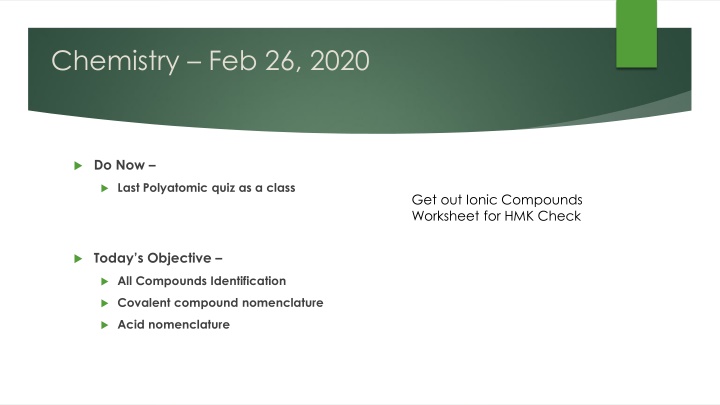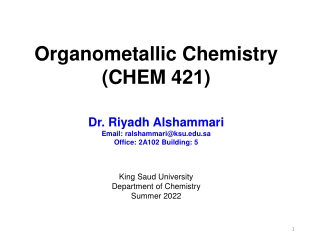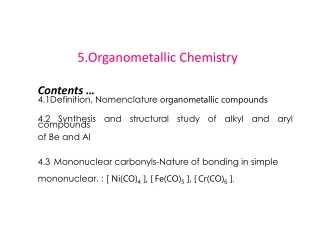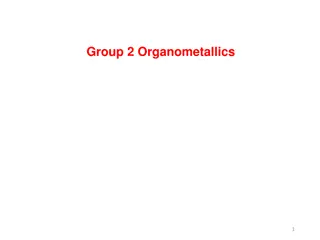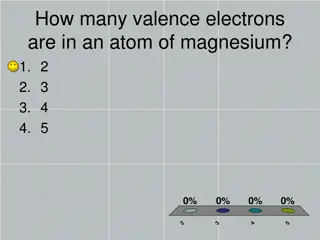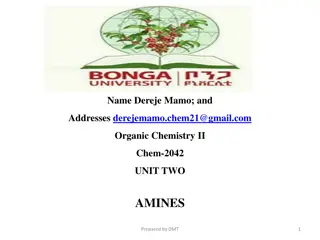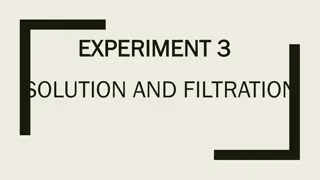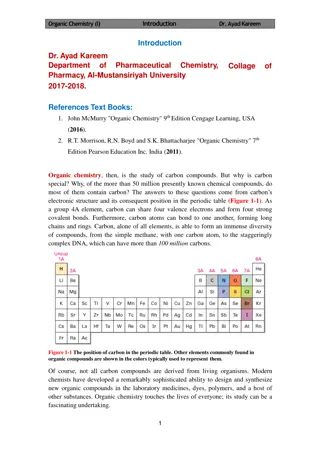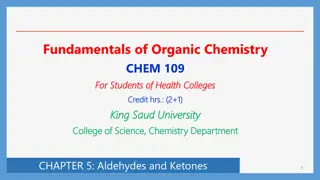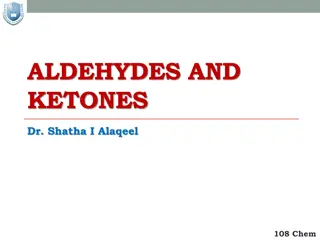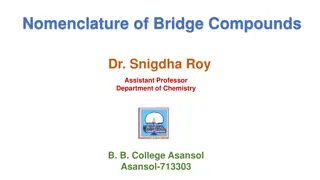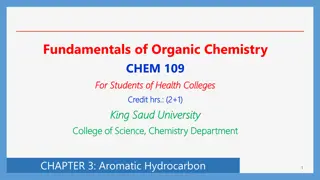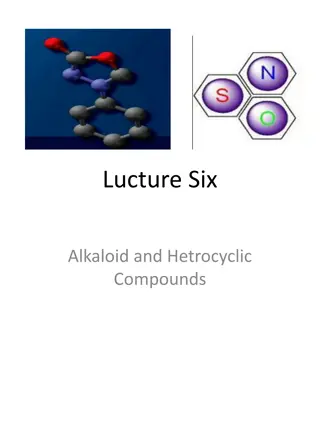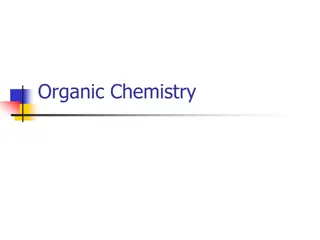Chemistry Feb 26, 2020: Compounds Identification & Nomenclature
In this chemistry class overview from February 26, 2020, students learn about identifying compounds, covalent compound nomenclature, and acid nomenclature. They reviewed and practiced naming various ionic compounds, covalent compounds, and acids. The homework review includes a wide array of compounds, from zinc chloride to aluminum sulfide. Students have assignments to complete worksheets on compound nomenclature. The provided images showcase the class objectives, worksheet tasks, and compound names for practice.
Download Presentation

Please find below an Image/Link to download the presentation.
The content on the website is provided AS IS for your information and personal use only. It may not be sold, licensed, or shared on other websites without obtaining consent from the author.If you encounter any issues during the download, it is possible that the publisher has removed the file from their server.
You are allowed to download the files provided on this website for personal or commercial use, subject to the condition that they are used lawfully. All files are the property of their respective owners.
The content on the website is provided AS IS for your information and personal use only. It may not be sold, licensed, or shared on other websites without obtaining consent from the author.
E N D
Presentation Transcript
Chemistry Feb 26, 2020 Do Now Last Polyatomic quiz as a class Get out Ionic Compounds Worksheet for HMK Check Today s Objective All Compounds Identification Covalent compound nomenclature Acid nomenclature
Chemistry Feb 26, 2020 Objective Agenda All Compounds Identification Polyatomic ion quiz Covalent compound nomenclature Homework Review Acids Compound Identification Covalent Nomenclature Acid Nomenclature Assignment: All Compounds Nomenclature Worksheet
Homework Review zinc iron (II) iron (III) gallium silver lead (IV) chloride ZnCl2 FeCl2 FeCl3 GaCl3 AgCl PbCl4 acetate Zn(C2H3O2)2 Fe(C2H3O2)2 Fe(C2H3O2)3 Ga(C2H3O2)3 AgC2H3O2 Pb(C2H3O2)4 nitrate Zn(NO3)2 Fe(NO3)2 Fe(NO3)3 Ga(NO3)3 AgNO3 Pb(NO3)4 oxide ZnO FeO Fe2O3 Ga2O3 Ag2O PbO2 nitride Zn3N2 Fe3N2 FeN GaN Ag3N Pb3N4 sulfate ZnSO4 FeSO4 Fe2(SO4)3 Ga2(SO4)3 Ag2SO4 Pb(SO4)2
Homework Review 1) copper (II) chloride CuCl2 lithium acetate LiC2H3O2 vanadium (III) selenide V2Se3 manganese (IV) nitride Mn3N4 beryllium oxide BeO 7) aluminum arsenide AlAs 2) 8) potassium permanganate KMnO4 chromium (VI) cyanide Cr(CN)6 10) tin (II) sulfite SnSO3 11) vanadium (V) fluoride VF5 12) ammonium nitrate NH4NO3 3) 9) 4) 5) 6) sodium sulfate Na2SO4
Homework Review 1) 2) 3) 4) 5) 6) 7) 8) 9) 10) Na2CO3 NaOH MgBr2 magnesium bromide KCl potassium chloride FeCl2 iron (II) chloride FeCl3 iron (III) chloride Zn(OH)2zinc hydroxide BeSO4 beryllium sulfate CrF2 chromium (II) fluoride Al2S3 aluminum sulfide sodium carbonate sodium hydroxide 11) 12) 13) 14) Co3N2 cobalt (II) nitride 15) Mg3P2 magnesium phosphide 16) Ga(NO2)3 gallium nitrite 17) Ag2SO3 18) NH4OH ammonium hydroxide 19) Al(CN)3aluminum cyanide 20) Be(CH3COO)2 beryllium acetate PbO Li3PO4 TiI4 lead (II) oxide lithium phosphate titanium (IV) iodide silver sulfite
Homework Review 21) sodium phosphide Na3P 22) magnesium nitrate Mg(NO3)2 23) lead (II) sulfite 24) calcium phosphate Ca3(PO4)2 25) ammonium sulfate (NH4)2SO4 26) silver cyanide AgCN 27) aluminum sulfide Al2S3 28) beryllium chloride BeCl2 29) copper (I) arsenide Cu3As 30) iron (III) oxide Fe2O3 31) gallium nitride GaN 32) iron (II) bromide FeBr2 33) vanadium (V) phosphate V3(PO4)5 34) calcium oxide CaO 35) magnesium acetate Mg(C2H3O2)2 36) aluminum sulfate Al2(SO4)3 37) copper (I) carbonate Cu2CO3 38) barium oxide BaO 39) ammonium sulfite (NH4)2SO3 40) silver bromide AgBr PbSO3
Classifying Compounds You can classify compounds based on their chemical formulas as ionic, molecular/covalent or acidic. Ionic both a metal element and a nonmetal element are present Ex: CaCl2 K2S NiS PbO2 Ionic a polyatomic ion is present Ex: NaOH K2SO4 Ca(MnO4)2 Molecular / Covalent only nonmetals are present, often C Ex: NO2 CO Acidic H is the first element listed. May have H listed twice. C2H6O IO3 Ex: HBr H2SO4 HClO2 HC2H3O2
Molecular compounds Formed between two nonmetals Special cases: CH4 = methane NH3 = ammonia Ion charges for the elements are irrelevant, electrons are shared Named as #prefixAelement #prefixBelementide #prefixes: mono, di, tri, tetra, penta, hexa, hepta, octa, nona, deca Mono dropped for 1st element Name carbon dioxide dinitrogen monoxide nitrogen dioxide phosporus triiodide Formula Formula OCl2 P2S3 NBr5 ClBr Name
Acid Nomenclature Overview Three nomenclature rules used for acids Based on the name of the anion that remains when the acidic H (s) are removed. Anions always end in either -ide, -ite, or -ate . This ending determines what naming rule is used. Cl- Chloride SO42- Sulfate Ex: HIO2 IO2- Ex: HCl -ide rule -ate rule -ite rule (Most are binary acids) (Oxoanions) (Oxoanions) Ex: H2SO4 Iodite
Binary Acids Acids are molecular compounds containing H that forms H+ ion and an anion when dissolved in water. Special cases: H2O = water H2O2 = hydrogen peroxide Binary acids have only two elements, Hydrogen and a nonmetal. Named as hydrononmetalic acid Name hydrochloric acid hydroiodic acid hydrosulfuric acid hydrophosphoric acid Formula Formula HBr HCN H2Se HF Name
Oxyacids Acids formed with polyatomic ions containing oxygen Polyatomic ions end in either ate or ite -ate ion based acids are named using oxyanion ic acid -ite ion based acids are named using oxyanion ous acid Name sulfuric acid hypochlorous acid nitrous acid phosphoric acid Formula Formula H2CO3 HNO3 HBrO4 HIO2 Name
Summary of Inorganic Naming Rules Type Naming Rule Type 1 Binary ionic one type of ion Type 2 Binary ionic multiple ions form Polyatomic ionic Molecular (two nonmetals) Binary acids Oxyacid from ate ion Oxyacid from ite ion metal nonmetalide metal (roman numeral) nonmetalide cation anion #prefixAelement #prefixBelementide hydrononmetalic acid oxyanion ic acid oxyanion ous acid
Mixed Practice Name Formula hypobromous acid KCl nitrogen dioxide HCl calcium sulfate Ba(CN)2 nitric acid Zn(C2H3O2)2 lithium selenide I2F5 nickel (II) chloride H3PO4 hydrosulfuric acid Cu2O
Exit Slip - Homework Exit Slip: 1) Name N2O5 2) Write the formula for bromic acid. What s Due? (Pending assignments to complete.) All Compounds Nomenclature Worksheet What s Next? (How to prepare for the next day) Read Holt p159-175 Mixed Nomenclature quiz on Monday.
